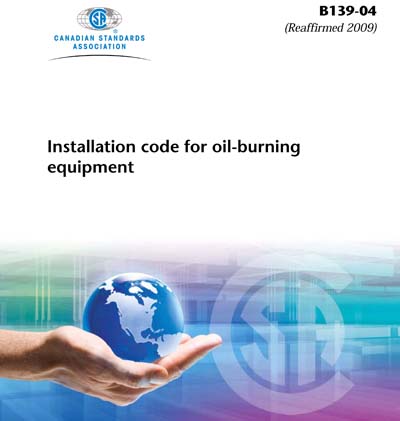Historical
CSA B139-2004 (R2009)
B139-04 (R2009) - Installation Code for Oil-Burning Equipment
1. Scope
1.1 This Code applies to (a) the installation of appliances, equipment, components, and accessories where oil is used for fuel purposes such as (i) forced-air furnaces; (ii) boilers; (iii) domestic water heaters; (iv) vehicle heaters; and (v) emergency power supplies for buildings; (b) the installation of all stationary and portable oil-burning equipment, including fuel supply, piping, and non-integrated tanks for fuel-oil-driven internal combustion engines; and (c) the installation of aboveground tanks that have a maximum individual capacity of 2500 L (550 gal) and a maximum aggregate capacity of 5000 L (1100 gal), and the piping and tubing systems from the tanks to the oil-fired appliance.Note: Fuel oil tank installations of any size underground, and aboveground installations over 2500 L (550 gal), are covered by the National Fire Code of Canada (NFCC) and the CCME Environmental Code. Tank installations may also be governed by the requirements of the authority having jurisdiction.
1.2 This Code provides minimum requirements for the installation of, or alterations to, oil-burning equipment, including (a) supply tanks as described in Clause 1.1 (c); (b) piping; (c) pumps; (d) control devices; (e) venting systems; and (f) central oil distribution.
1.3 This Code provides minimum requirements for the installation of, or alterations to (a) accessories; and (b) heating distribution systems insofar as these affect the proper operation of the oil-burning equipment.
1.4 This Code does not apply to (a) equipment installed in refineries; (b) appliances installed in mobile housing, recreational vehicles, and marine craft; (c) lamps; and (d) such portable devices as blowtorches, melting pots, and weed burners.
Note: For installation of oil-burning equipment in mobile housing and recreational vehicles, refer to CAN/CSA-Z240 MH Series.
1.5 This Code provides requirements for the maintenance of the most commonly used types of oil-burning equipment as detailed in Clause 14.
1.6 Annex G provides the recommended precautions for filling tanks.
1.7 The values given in SI (metric) units are the standard. The values given in parentheses are for information only.
1.8 In CSA Standards, "shall" is used to express a requirement, i.e., a provision that the user is obliged to satisfy in order to comply with the standard; "should" is used to express a recommendation or that which is advised but not required; and "may" is used to express an option or that which is permissible within the limits of the standard.
Notes accompanying clauses do not include requirements or alternative requirements; the purpose of a note accompanying a clause is to separate from the text explanatory or informative material.
Notes to tables and figures are considered part of the table or figure and may be written as requirements. Legends to equations and figures are considered requirements.
Content Provider
CSA America, Inc. [csa]






